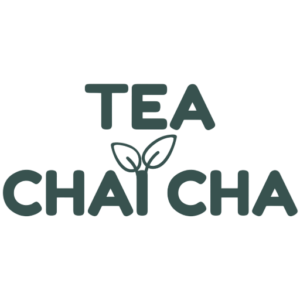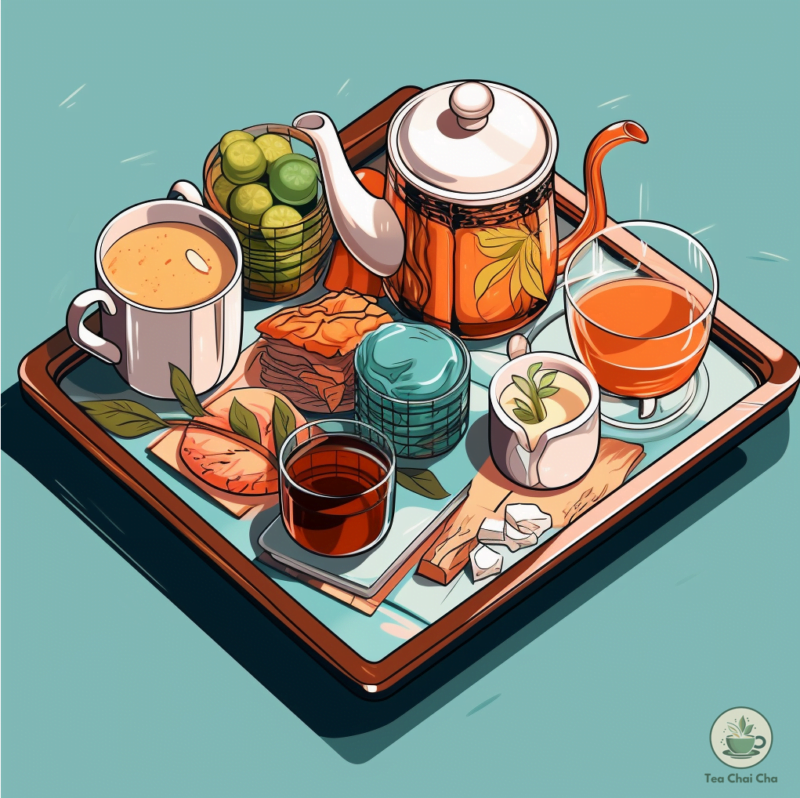Curious about the hidden wonders a humble cup of tea can reveal? Ever wondered how a simple beverage could become a mirror to diverse cultures, a practice of mindfulness, and a unifying social bond?
Today, we will explore the art of tea ceremonies – a sublime spectacle interlacing history, tradition, mindfulness, and of course, the universal adoration for tea, chai, cha.
What is a Tea Ceremony?
A tea ceremony is a ritualized form of making and drinking tea, often steeped in cultural, religious, or spiritual symbolism and tradition.
The process typically involves detailed preparation and presentation techniques that highlight respect, purity, tranquility, and harmony. Such ceremonies can be quite formal and may include specific equipment, actions, attire, and etiquette.
The act of the tea ceremony is not simply about drinking tea, but is intended to foster a moment of deep connection with oneself and others, to appreciate the art of tea-making, and to create a mindful, aesthetic experience that transcends the everyday world.
The specifics of the ceremony can vary widely depending on the culture in which it is performed.
Also read – The History of Tea
Tea Ceremonies around the Globe: A Symmetry of Culture and Tradition
Tea, a humble beverage that emerged from the heartland of China, has seeped into the corners of the world, intermingling with local cultures and traditions. Today, it’s not just a drink; it’s a symphony of cultural narratives told through unique ceremonies. Let’s embark on a fascinating journey, exploring tea rituals across the globe.
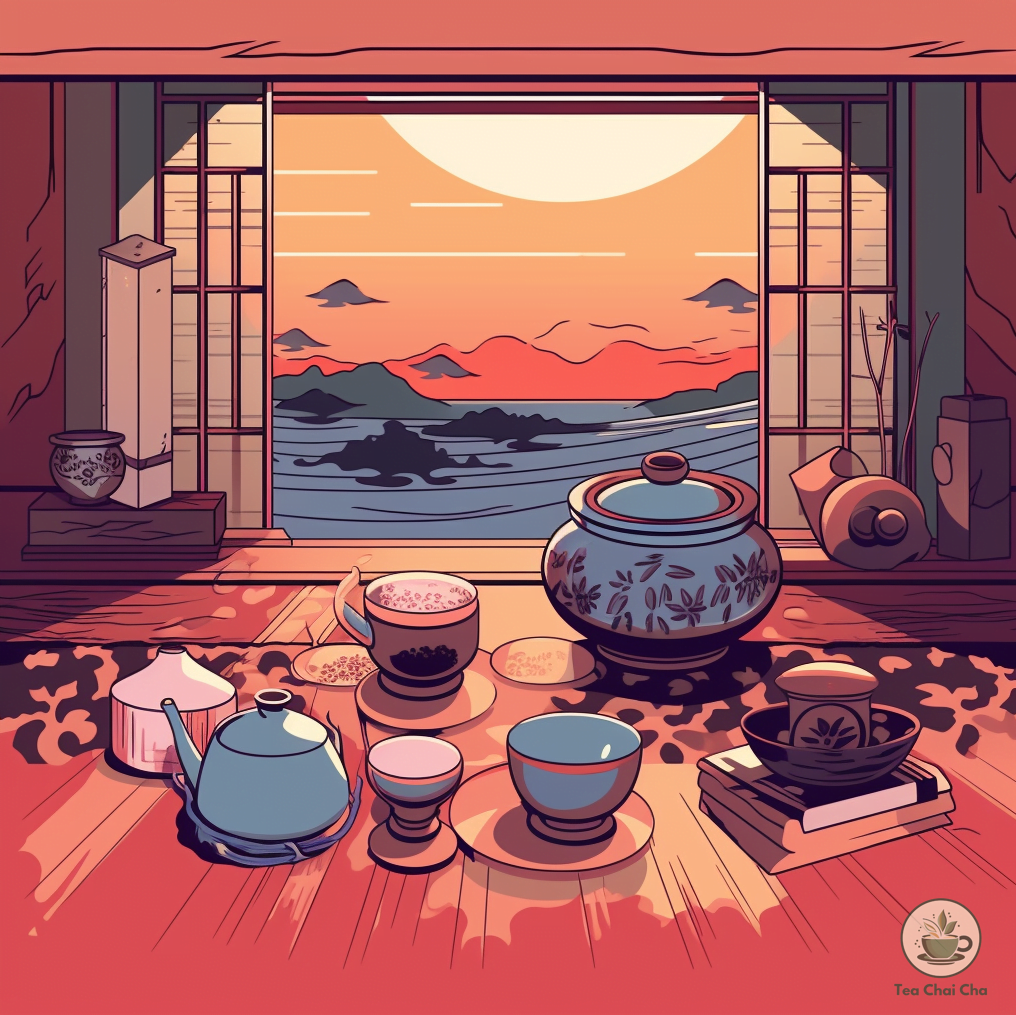
The Japanese Tea Ceremony: Chado or “The Way of Tea”
Our first port of call is Japan, where the “Way of Tea”, or Chado, is less a ceremony and more a meditative practice, deeply intertwined with Zen philosophy.
Unveiling the Four Principles of Chado
- Harmony (Wa): An emphasis on unity with nature and others, reflected in every aspect of the ceremony, from the tea house’s design to the selected utensils.
- Respect (Kei): Demonstrated through every gesture and word, encouraging mindfulness and appreciation of the experience.
- Purity (Sei): A reminder to cleanse one’s mind and heart, often symbolized through the purification of tea utensils.
- Tranquility (Jaku): The ultimate goal of the ceremony, a state of serene calmness achieved through disciplined practice.
A Glimpse into Japanese Culture
Chado captures the essence of Japanese culture, focusing on humility, restraint, and refined aesthetics, allowing participants to leave the bustling world behind and find solace in simplicity.
Turning the Pages of History
The origins of Chado date back to the 9th century, combining Zen Buddhism’s principles with the Samurai class’s ideals. The ceremony has evolved significantly, yet continues to hold a revered place in Japanese society.
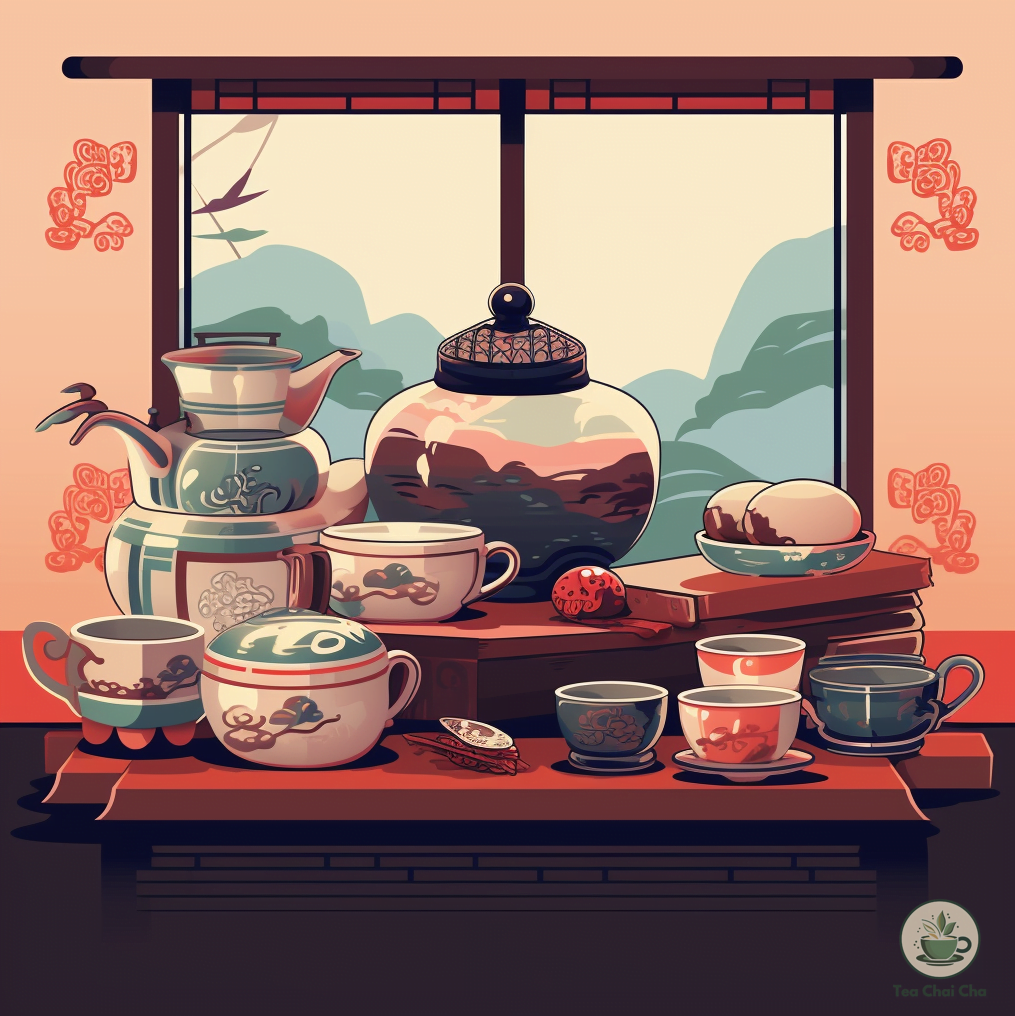
The Chinese Tea Ceremony: Gongfu Tea
Moving to the birthplace of tea, China, we encounter the celebrated Gongfu Tea ceremony. Gongfu, translating to “making tea with skill”, transforms tea brewing into an art form.
Unlocking the Flavor Code
Gongfu tea brewing revolves around the idea of extracting the full potential of the tea leaves. Key aspects include:
- Tea selection: High-quality, loose-leaf teas are preferred, often Oolong or Pu-erh.
- Water temperature: Varies based on the tea type, crucial for bringing out the right flavors.
- Brewing time: Carefully controlled to prevent over-extraction and maintain a balance of flavors.
Exploring Artistry in Detail
Every step and utensil in the Gongfu ceremony holds a symbolic meaning:
- Tea Pot (Yixing pot): Known for its unique clay, enhancing the tea’s flavor over time.
- Tea Pitcher (Cha Hai): Ensures equal distribution of tea for all guests.
- Tea cups (Pinming cups): Small cups that emphasize the tea’s aroma and flavor.
The Deep Roots of Gongfu Tea
Tracing Gongfu Tea’s evolution leads us back to the Chaozhou region during the Song Dynasty (960-1279 AD). Initially a medicinal practice, it blossomed into a cultural staple over centuries.
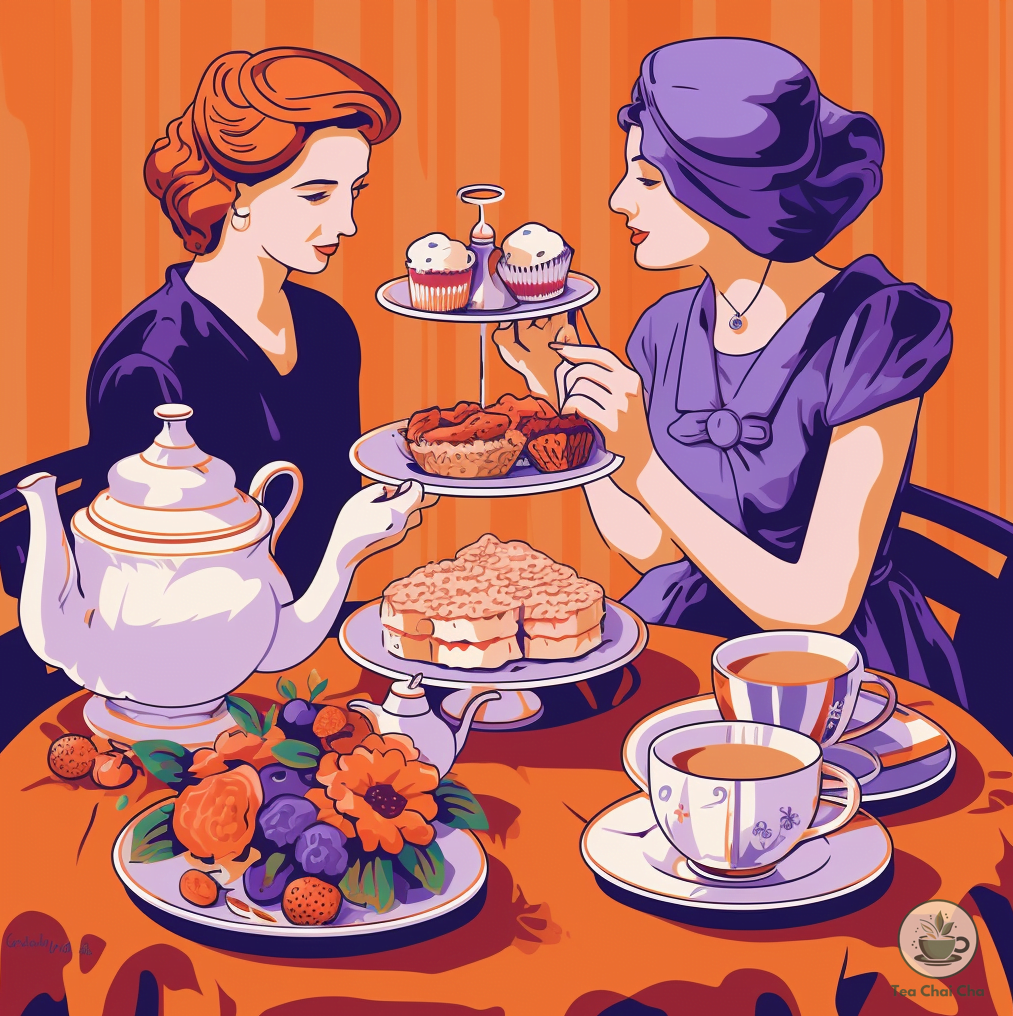
British Afternoon Tea: A Classic European Encounter
Our journey takes us next to the British Isles, where Afternoon Tea holds an esteemed position as a cherished social event, harking back to the Victorian era.
The British Stamp on Tea Culture
British Afternoon Tea is an elegant affair, featuring:
- The Tea: Often a strong black tea like Assam or Darjeeling, sometimes served with milk.
- The Sandwiches: Delicate finger sandwiches with fillings like cucumber, egg and cress, or smoked salmon.
- The Sweets: Scones with clotted cream and jam, followed by a selection of cakes and pastries.
Mastering the Art of Pairing
Pairing the right food with tea is crucial to an authentic British Afternoon Tea experience. For instance, a robust Assam pairs beautifully with heartier fillings like roast beef sandwiches, while a lighter Darjeeling complements cucumber sandwiches and scones.
High Tea vs Afternoon Tea
Despite common misconception, High Tea and Afternoon Tea are distinct traditions. Afternoon Tea, a lighter meal served with cakes and sandwiches in the late afternoon, was a social event for the upper classes. High Tea, served later in the day, was a more substantial meal for the working class.
Also read – Tea-producing Regions Worlwide
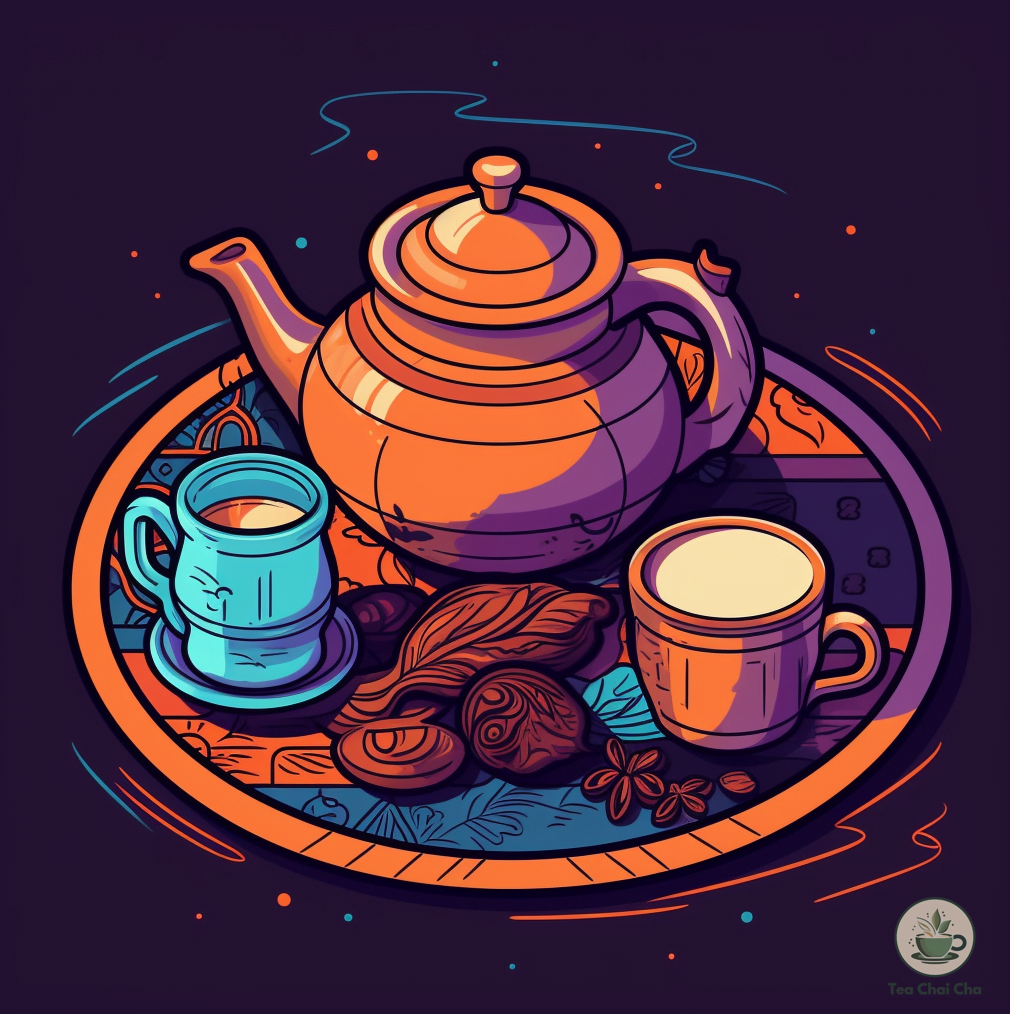
The Indian Chai Ceremony: A Burst of Spices and Colors
Next, we head to the bustling streets of India, where ‘Chai‘ — a vibrant brew of tea, milk, sugar, and a medley of spices — paints a colorful picture of the country’s culinary landscape.
Creating the Spice Symphony
Each ingredient in Masala Chai plays a unique role:
- Tea: Strong black tea forms the base of the brew.
- Spices: Cardamom, cinnamon, ginger, and cloves are the most commonly used spices, each adding a layer of complexity to the flavor profile.
- Milk and Sugar: Lend the chai its characteristic creamy sweetness.
Culture in a Cup
Chai is more than just a beverage in India. It’s a conversation starter, a warm welcome for guests, a comforting breakfast staple, and a refreshment for evening breaks. The “Chai Wallahs” or tea vendors at every street corner brewing their special chai are iconic figures in India’s cities and towns.
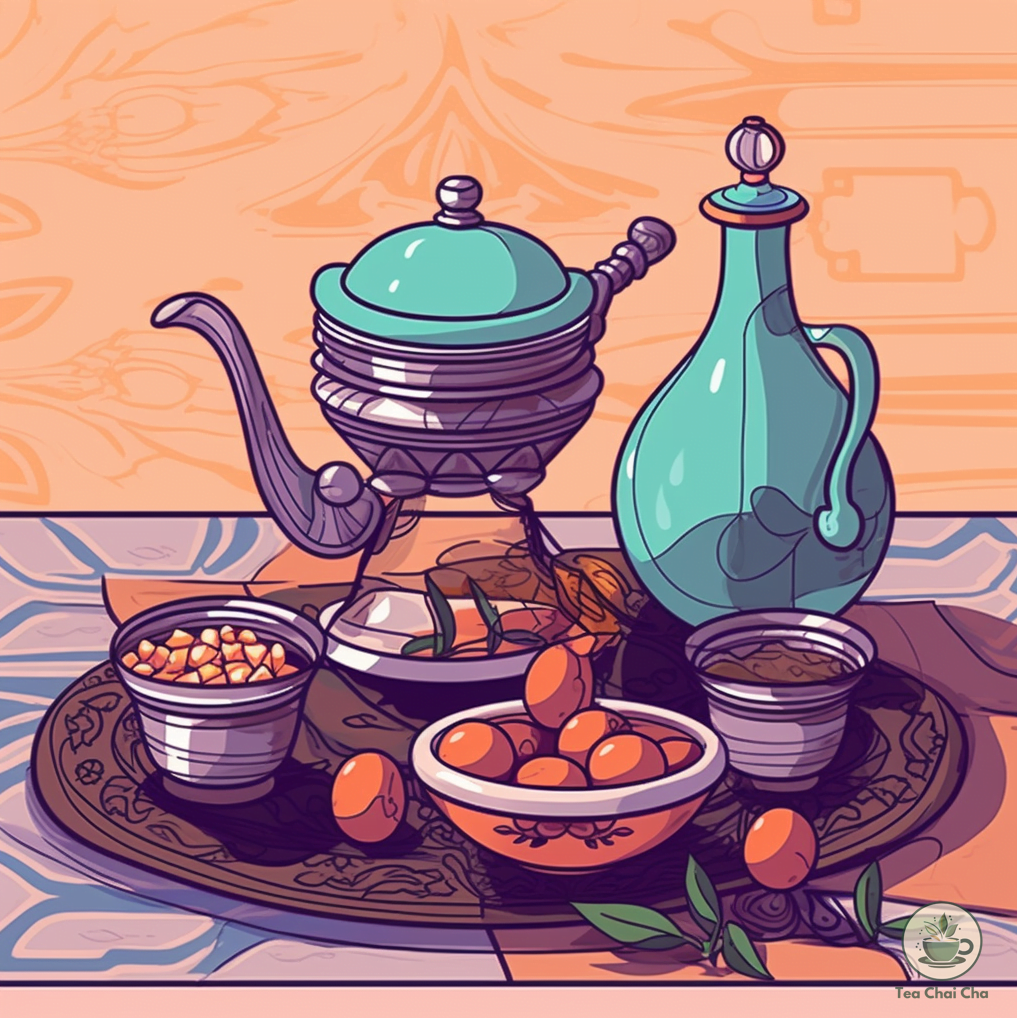
Moroccan Mint Tea Ceremony: An Emblem of Hospitality
After the vibrant spices of India, we find ourselves in the aromatic lands of Morocco, where tea, particularly mint tea, is a symbol of hospitality and friendship.
Mint and More in Every Sip
Moroccan Mint Tea combines green tea, mint leaves, and ample sugar to create a sweet, refreshing brew. Key aspects include:
- Green tea: Gunpowder tea is typically used, offering a robust base for the strong flavors to come.
- Mint: Fresh spearmint leaves give the tea its characteristic cooling flavor.
- Sugar: Moroccan tea is notoriously sweet; the sugar not only sweetens the brew but also helps to extract the flavors from the mint leaves.
The Rituals of Moroccan Hospitality
The Moroccan tea ceremony involves a beautiful, elaborate ritual:
- Brewing: The tea is brewed in a special metal teapot, often silver or brass, over a charcoal brazier.
- Serving: The tea is poured from a height into small, delicate glasses, creating a frothy top — a skill that showcases the host’s proficiency.
Visual Delight: Moroccan Tea Sets
Moroccan tea sets are a feast for the eyes. Uncover the beauty and symbolism behind these intricately designed sets:
- Teapot: Often engraved with intricate designs, symbolizing the Moroccan culture.
- Glasses: Usually brightly colored and painted with detailed patterns, signifying Moroccan artistry.
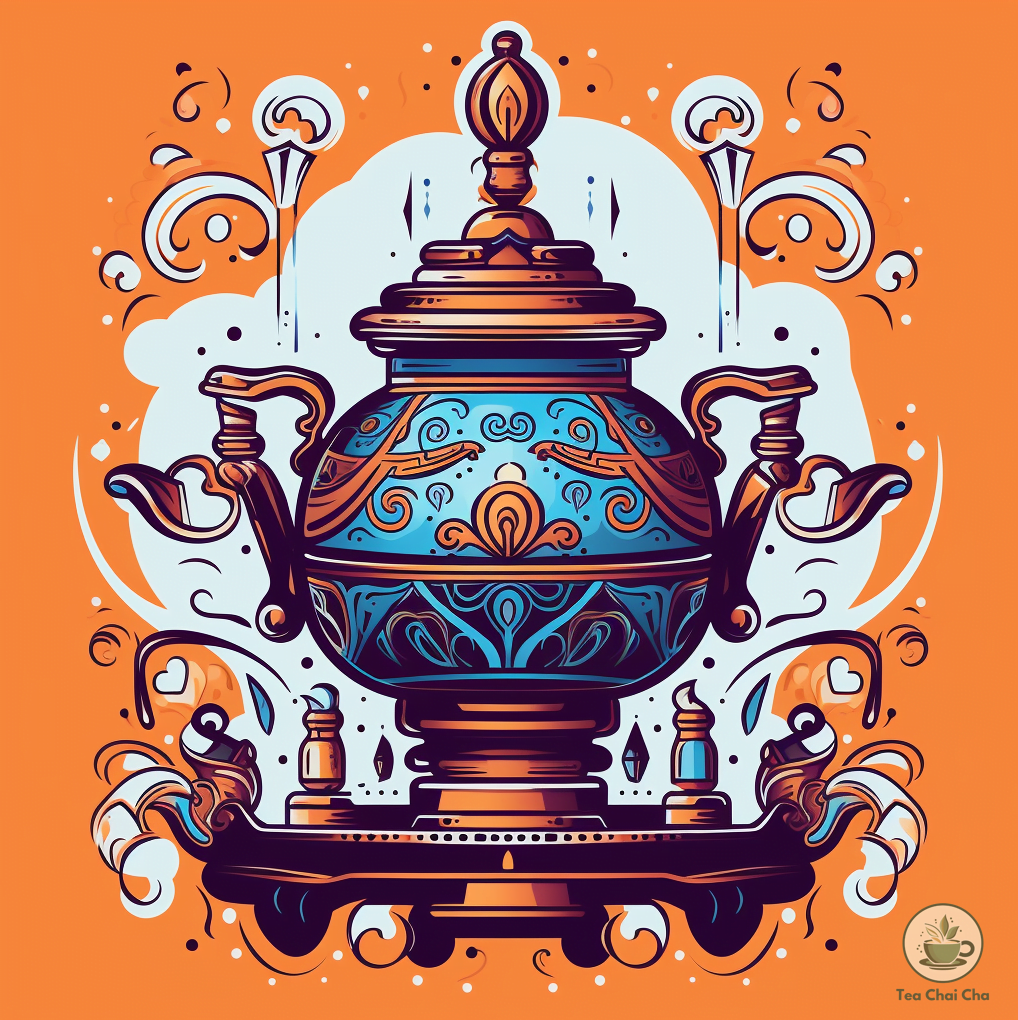
Russian Samovar Tea Ceremony: A Symbol of Unity
From the aromatic lanes of Morocco, we journey to the cold terrains of Russia. Here, we find a unique tea tradition that dates back to the 18th century: the Samovar Tea ceremony.
Samovar and Its Significance
A Samovar is a large metal container used to boil water, around which the entire Russian tea ceremony revolves. The Samovar represents unity and camaraderie, as families and friends gather around to enjoy tea during long, cold winters.
The Dual Brew Method
In this ceremony, a strong, concentrated tea brew, known as ‘Zavarka‘, is prepared separately. This is then diluted with hot water from the Samovar to suit individual preferences.
Food and Russian Tea
Russian tea ceremonies are incomplete without traditional snacks. This includes ‘Sushkie’, a type of sweet bread, honey, and an array of jams. The sweetness of the food contrasts beautifully with the usually robust and bitter Russian tea.
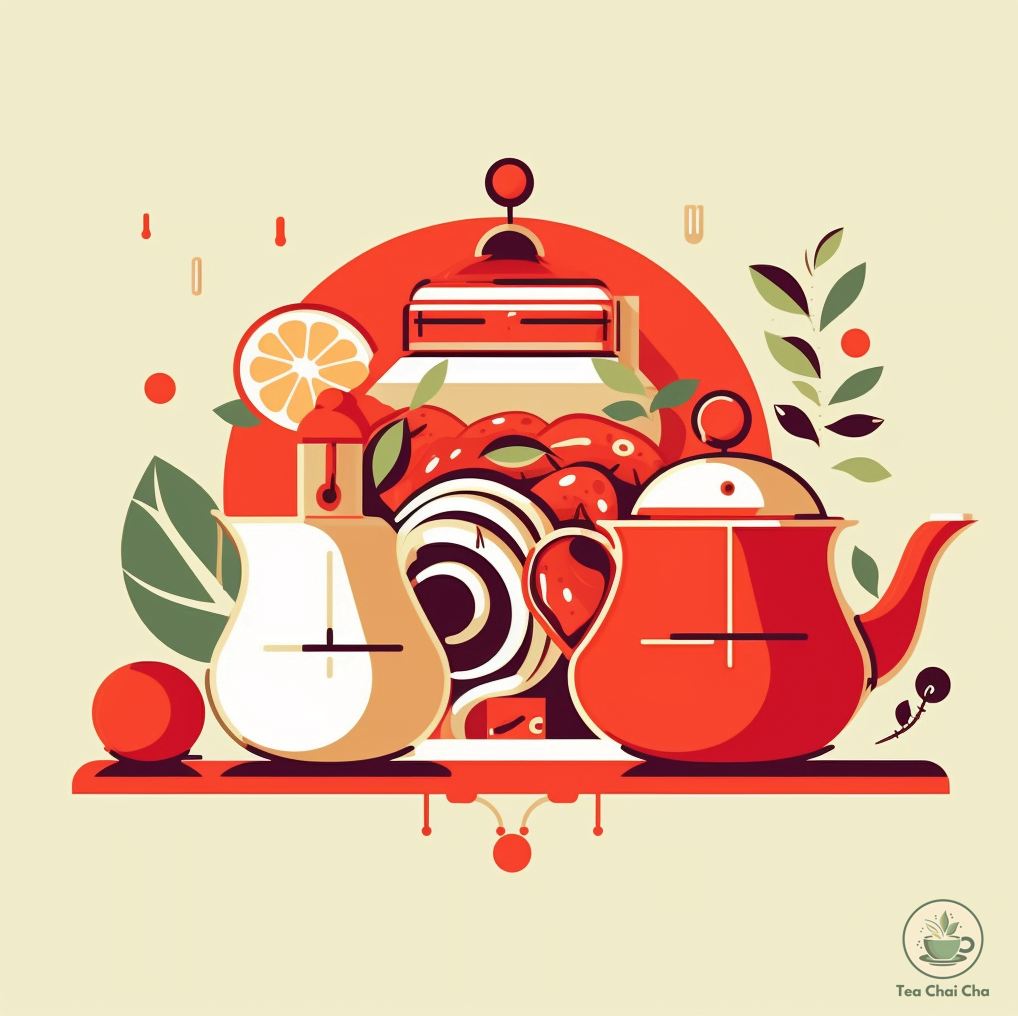
Tools of the Tea Ceremony: Craftsmanship meets Utility
As we have journeyed through the rich tapestry of global tea traditions, we’ve noticed one common thread — the intricate tools that bring these ceremonies to life. Each tool is a testament to centuries of tradition, craftsmanship, and culture. They are not only functional but symbolic, carrying hidden meanings and nuances within their designs.
Essential Instruments of a Tea Ceremony
Across the globe, certain instruments are integral to the art of tea ceremonies. Each culture has carefully crafted these tools to enhance the tea drinking experience and reflect their aesthetic heritage.
Teapots: Masterpieces of Design and Function
From the sturdy Japanese Tetsubin to the ornate Moroccan Berrad, each culture has its unique teapot:
- Tetsubin: Japanese iron teapots, renowned for their heat retention and health benefits.
- Berrad: Moroccan teapots, typically made from silver or brass, appreciated for their intricate engravings and beautiful shapes.
- Samovar: A large Russian urn used for boiling water and brewing tea, symbolizing unity and togetherness.
- Yixing: Chinese clay teapots, known for their unique ability to absorb tea flavors, enhancing the brew over time.
Tea bowls and Cups: Enhancing Sensory Pleasure
Ranging from the deep ‘Chawan’ of Japan to the petite ‘Istikan’ of Morocco, these vessels are not just receptacles for tea, but a crucial part of the aesthetic and sensory experience:
- Chawan: Japanese tea bowls, used in the Way of Tea, each handcrafted and unique.
- Istikan: Moroccan tea glasses, known for their rich colors and intricate designs.
- Cha Bei: Chinese tea cups, often used without handles, allowing drinkers to enjoy the warmth of the brew.
Tea Whisks, Scoops, and Sticks: The Subtle Tools
Often overlooked, these tools are crucial in the preparation and serving of tea. Each is crafted with a specific purpose:
- Chasen: A bamboo whisk used in Japanese tea ceremonies to mix Matcha powder with hot water.
- Cha Ze: A Chinese tea scoop, traditionally made from bamboo, used to portion tea leaves.
- Cha Shao: Tea tweezers used in Chinese tea ceremonies to handle hot tea cups.
In the next section, we delve deeper into the preparation for a tea ceremony, providing insights into the world of tea selection and the science of water, two critical components for achieving the perfect brew.
Also read – Tea Accessories and their Uses
The Art and Science of Preparing for a Tea Ceremony
In the realm of tea ceremonies, there’s a profound appreciation for preparation. It’s not merely a preamble but an integral part of the ceremony, setting the stage for the sensory experience that follows. The journey starts with choosing the perfect tea and understanding the pivotal role of water in the brewing process.
Choosing Your Tea: The First Step Towards an Unforgettable Ceremony
Picking the right tea is both an art and a science. It’s about appreciating the unique character of different tea types, understanding how their distinct flavors and aromas harmonize with the spirit of various ceremonies:
- Exploring the Tea Spectrum: From the frothy Matcha, a green tea powder used in Japanese tea ceremonies, to the whole-leaf teas used in Chinese Gongfu ceremonies, or the gunpowder green tea used in Moroccan ceremonies, each variety offers a unique sensory experience. Become familiar with these variations to make an informed choice.
- Seasonal Selections: In the world of tea, seasons matter. Certain teas are associated with specific times of the year. For instance, Japanese tea ceremonies often use Shincha, the first flush of green tea, in spring. Knowing these seasonal preferences enhances the authenticity of your ceremony.
- Quality Counts: Just as wine connoisseurs favor particular vineyards, tea lovers recognize the importance of tea origin and quality. From the high mountain Oolongs of Taiwan to the verdant green teas of Uji, Japan, your choice of tea leaves can make a significant difference in your ceremony’s overall experience.
Mastering the Water: The Elixir of Life
Water is often considered the mother of tea in tea ceremonies. Its quality and temperature can greatly influence your brew:
- The Essence of Water: Ideally, tea should be brewed with soft water, rich in oxygen but low in mineral content. This type of water allows the full flavor of the tea leaves to shine through without being masked by any mineral aftertaste. Learn about various water sources and how to select the best one for your tea.
- Temperature Matters: Each tea type has its ideal water temperature, which helps to extract the perfect balance of flavor, aroma, and color. For instance, delicate green teas require cooler water than robust black teas to prevent the release of bitter compounds. Mastering this temperature play is key to creating a delicious brew.
Tea Ceremony Sequence
A tea ceremony is more than the sum of its parts; it’s a finely orchestrated dance between the host and the guests:
- Learning the Flow: Each tea ceremony, whether it’s Japanese Chado or British Afternoon Tea, has its tea ceremony sequence, reflecting its unique cultural roots. Familiarize yourself with this flow, from purifying the utensils to serving the tea, to conduct a smooth and immersive ceremony.
- Ritual and Improvisation: While it’s important to respect traditional steps, there’s also space for personal touch and creativity. You might want to infuse your ceremony with a theme, choose a unique set of tea utensils, or introduce a special type of tea.
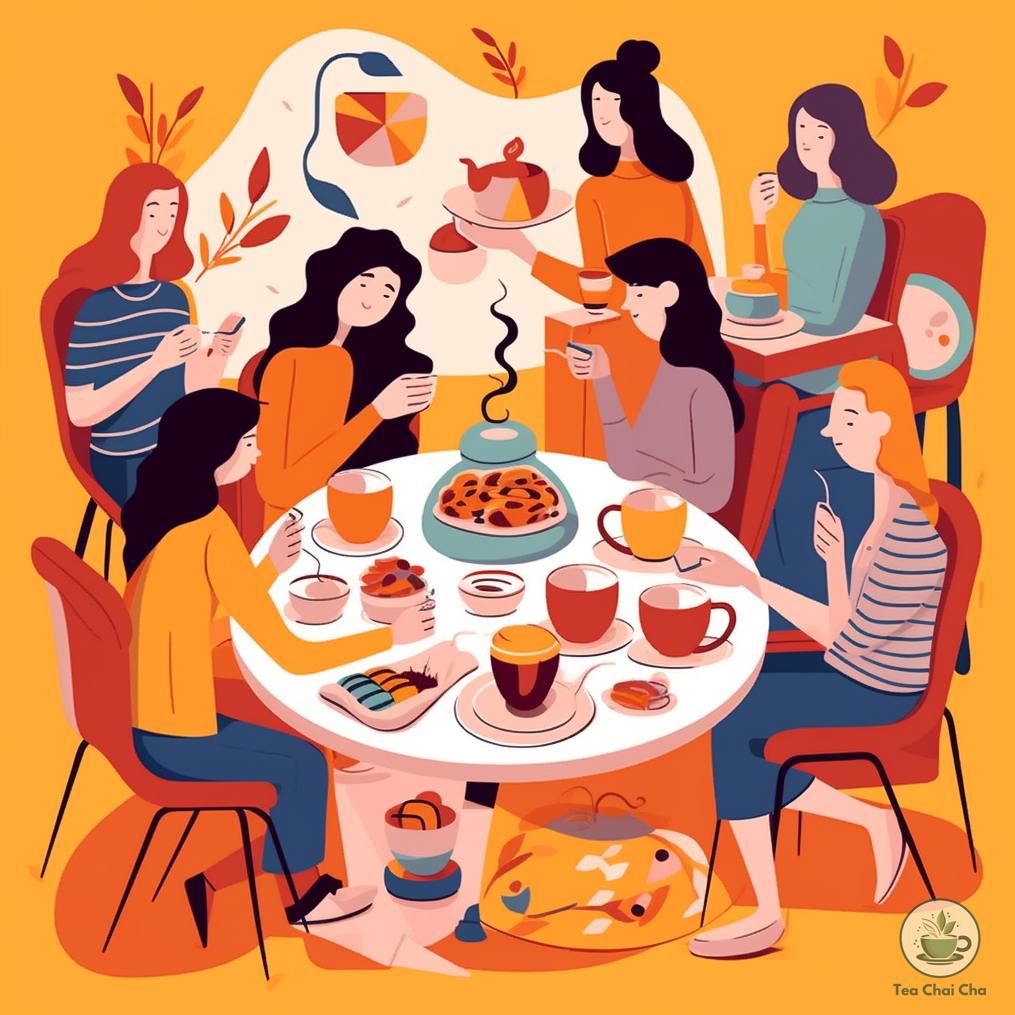
Experiencing a Tea Ceremony: A Multisensory Symphony
A tea ceremony is an intimate sensory journey, a tapestry woven from threads of sight, scent, taste, touch, and sound. It invites you to slow down and savor the details, creating a space for mindfulness and connection. Let’s explore how each sense is engaged and celebrated during a tea ceremony.
Visual Aesthetics: An Artistic Tableau
A tea ceremony is visually rich, where every element is designed for aesthetic delight and symbolic significance:
- The Harmony of Space: From the arrangement of the tea utensils to the decor of the room, visual harmony sets the stage for the ceremony. Discover the principles of creating an inviting and serene tea environment, incorporating aspects of light, color, and decor that resonate with the spirit of the ceremony.
- The Elegance of Utensils: Each tool used in a tea ceremony is a work of art, reflecting centuries of craftsmanship and cultural nuances. Learn to appreciate their form, texture, and placement – all of which add to the visual tapestry of the ceremony.
Scent and Taste: The Heart of the Ceremony
The core of any tea ceremony is the tea itself, engaging the senses of smell and taste:
- The Dance of Aromas: Each tea type unfurls a distinct aroma when brewed, which forms a pivotal part of the ceremony. Learn how to appreciate the complex bouquet of scents released by different teas, from the vegetal freshness of Japanese green tea to the sweet, earthy notes of Chinese Pu-erh.
- The Symphony of Flavors: From the initial sip to the lingering aftertaste, tea offers a rich spectrum of flavors. Learn the art of tea tasting, understanding the nuances between bitterness, sweetness, astringency, and umami that different teas present.
Sound and Touch: Echoes of Tranquility
The tea ceremony also engages the oft-overlooked senses of sound and touch, adding depth to the experience:
- Sounds of Serenity: The tea ceremony is a symphony of subtle sounds, from the gentle whirl of the whisk in the matcha bowl to the soft pour of water into the teapot. These sounds, often overlooked in our everyday rush, form an auditory backdrop that invites relaxation and mindfulness.
- Touchpoints of Warmth: From the weight of the teapot in your hand to the warmth of the tea cup against your lips, the tea ceremony is replete with tactile sensations. Explore how these touches can deepen your sense of connection and presence within the ceremony.
Experiencing a tea ceremony goes beyond simply drinking tea. It’s an immersive, multisensory experience that invites you to engage fully with the present moment. So the next time you partake in a tea ceremony, remember – it’s not just about savoring the tea, but savoring the experience in its entirety.
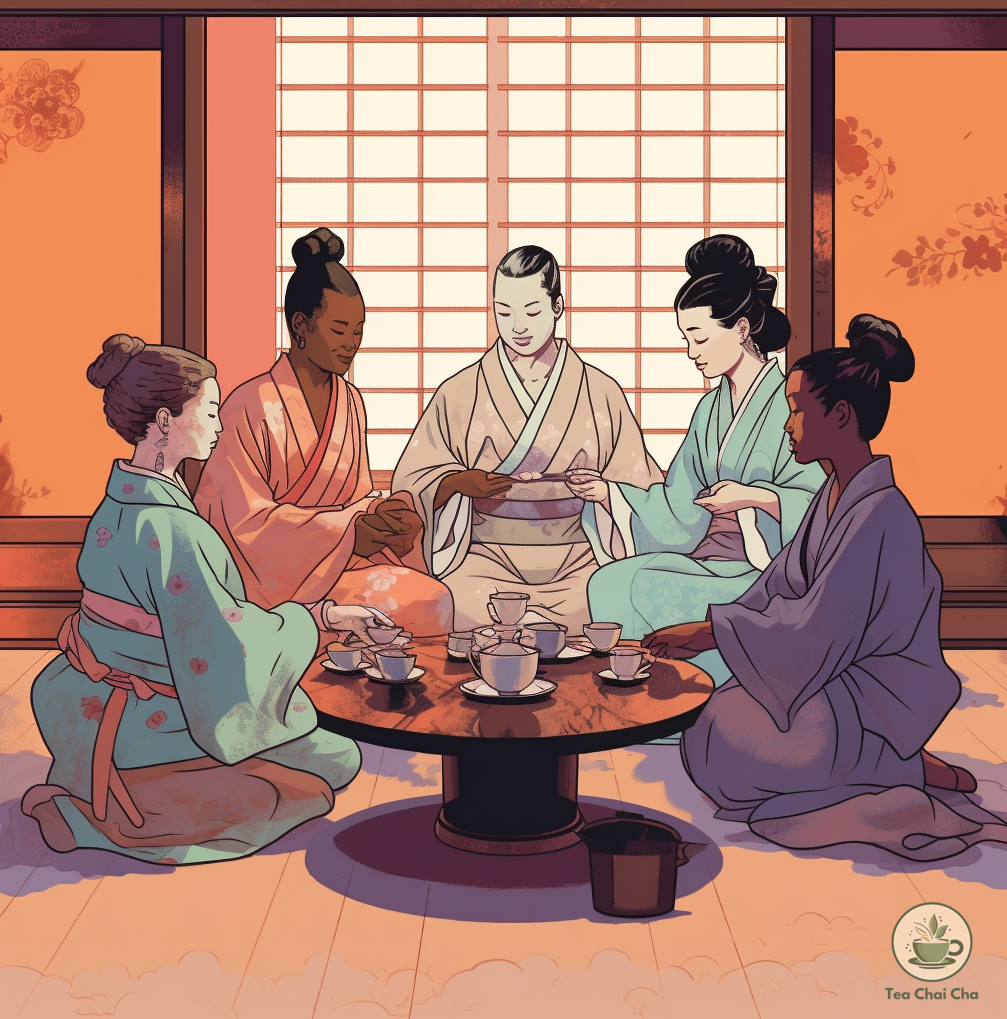
Hosting Your Own Tea Ceremony: A Step-by-Step Guide
Hosting a tea ceremony is an enchanting experience that unfolds layers of tradition and mindfulness. It is an opportunity to create a space of warmth, tranquility, and connection with your guests. Here are some detailed steps and tips to help you host a memorable tea ceremony.
Preparation: Setting the Stage
The crux of a successful tea ceremony lies in meticulous preparation. From the perfect tea leaves to the ambiance of the room, each detail weaves together to create a harmonious setting.
Preparation Checklist:
- Tea Selection: Choose a tea that complements the ceremony’s style. A ceremonial-grade Matcha for a Japanese Chado or a robust black tea for an English high tea, for instance.
- Tea Tools: Gather all the required tea tools, including teapot, tea whisk, bowls, or cups, and a tea scoop or spoon.
- Water: Ensure you have access to soft, oxygen-rich water, which is ideal for brewing tea.
- Atmosphere: Prepare the ceremony room, taking into account factors such as lighting, temperature, decor, and seating.
Room Setup Tips:
- Lighting: Aim for soft, diffused light. If possible, make use of natural light to foster a serene ambiance. Candles can also be used for a softer glow.
- Seating: Arrange the seating in a circular or semi-circular format. This encourages interaction and makes serving easier.
- Decor: Align your decor with the style of the ceremony. A scroll or simple flower arrangement for a Japanese ceremony, or vibrant cushions and carpets for a Moroccan one, can enhance authenticity.
- Temperature: A comfortable temperature is essential for a relaxed tea ceremony. Ensure the room is neither too cold nor too warm.
Conducting the Tea Ceremony in Sequence
Mastering the ceremony requires understanding the traditional sequence of actions and performing them with grace. Here’s a flow chart to help you visualize the steps and a list of common errors to avoid.
Ceremony Flow Chart:
- Guest Arrival: Warmly welcome your guests and guide them to their seats. Provide a brief introduction to the tea and the ceremony.
- Tea Preparation: Mindfully prepare the tea in front of your guests. This is not just a process, but a performance of deliberate actions.
- Serving the Tea: Begin by serving the guest of honor and continue to each guest. Serve with both hands to show respect.
- Enjoyment and Conversation: Invite guests to savor the tea and partake in gentle conversation.
Inviting Guests: Etiquette and Considerations
The charm of a tea ceremony lies in shared experiences. Hence, the way you invite your guests and their understanding of tea ceremony etiquette significantly impacts the ceremony’s success.
How to Extend a Heartwarming Invitation:
A tea ceremony invitation should be personal and warm. Mention the purpose of the gathering and give a brief overview of what they can expect. If it’s a themed ceremony, let your guests know, so they can dress appropriately.
Tea Ceremony Etiquette: A Quick Guide for Guests:
It’s essential to inform your guests about basic tea ceremony etiquette. This could include rules about punctuality, appreciation of the tea and the ceremony, and participating in tea-related conversations. Each ceremony, depending on its cultural background, may have specific etiquettes to follow.
Engaging Your Guests: The Art of Tea Conversation
Creating engaging conversation is key to a memorable tea ceremony. Here are some topics to discuss and a fun, interactive activity to involve your guests.
Conversation Starters:
- Tea Legends and Folklore: Share interesting stories about the origins of tea or legends associated with tea in different cultures.
- Tea Varieties and Tasting Notes: Discuss the wide spectrum of tea varieties and the unique tasting notes of each.
- Tea Etiquette: Talk about different tea etiquettes around the world. This could be a fun and informative discussion!
Interactive Activity – Tea Tasting:
- Tasting Rounds: Invite each guest to share their experience of the tea – its aroma, taste, and how it makes them feel.
- Blind Tasting: For a fun twist, conduct a blind tasting. Ask guests to guess the type of tea or pick out specific flavors.
Serving the Tea: A Final Touch of Hospitality
Serving tea is not merely an act but a gesture of hospitality. Done with grace and warmth, it can elevate your tea ceremony.
Mastering the Art of Serving Tea:
Attention to detail is key when serving tea. Ensure the tea is neither too hot nor too cold. Pour tea with both hands as a sign of respect, and while serving, make sure to start with the guest of honor.
A Memorable Farewell: Concluding the Tea Ceremony with Elegance:
Conclude the tea ceremony with a simple thank you note appreciating your guests’ presence. You could also give a small tea-related favor as a memento of the experience.
Common Mistakes and Tips to Avoid Them:
- Oversteeping Tea: Oversteeping can make tea bitter. Use a timer to avoid this.
- Ignoring Guest Comfort: Regularly check if guests are comfortable. Ask if the tea is to their liking or if they need anything else.
Conclusion: Last Sip of the Chai Ceremony
A tea ceremony is not just about brewing and drinking tea. It’s a transformative journey that teaches us about mindfulness, respect, and connection. Hosting your own tea ceremony can provide you with a unique perspective on this ancient tradition.
We hope that this guide has not only given you a comprehensive understanding of hosting a tea ceremony but also inspired you to embark on your own tea ceremony journey.
Remember, every tea ceremony is unique and reflects the host’s personality and style. So, brew your tea, gather your friends, and let the tea tales unfold!
